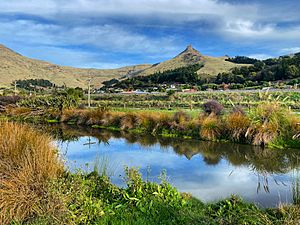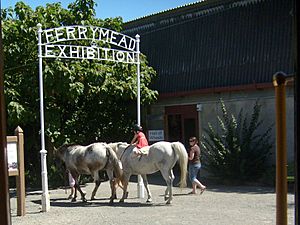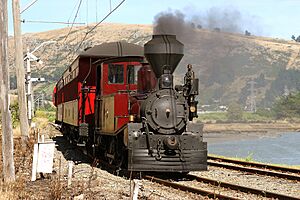Ferrymead facts for kids
Quick facts for kids
Ferrymead
|
|
|---|---|
|
Suburb
|
|

Ferrymead Regional Park
|
|
| Country | New Zealand |
| Local authority | Christchurch |
| Electoral ward | Heathcote |
| Area | |
| • Land | 228 ha (563 acre) |
| Population
(June 2023)
|
|
| • Total | 1,110 |
|
|
||
Ferrymead is a suburb located in the south-east part of Christchurch, New Zealand. It's a key area for getting to the eastern beach suburbs like Sumner. You'll also find many homes and businesses built on the cliffs overlooking the water. After the big 2011 Canterbury earthquake, many important Christchurch businesses moved to Ferrymead. This made it a busy new hub for shops and offices.
Contents
Exploring Ferrymead's Location
Ferrymead is right next to the Avon Heathcote Estuary / Ihutai. This is where the Ōpāwaho / Heathcote River flows into the wider estuary. Just three kilometers to the west, the estuary opens up into Pegasus Bay.
To the north of Ferrymead, there are special ponds that are part of Christchurch's water treatment system. These ponds are also a large wildlife area. Many different kinds of birds live there, making it a great spot for nature lovers. To the south, you can see the beautiful Port Hills.
The name Ferrymead comes from a ferry that used to cross the Ōpāwaho / Heathcote River. This was in the very early days when people first settled here. After the 2011 earthquake, many businesses moved to Ferrymead. This helped the area grow, bringing new shops and cafes.
Ferrymead's Past: A Glimpse into History
Early Days of Settlement
European settlers first arrived in the Ferrymead area around 1850. Farming was the main activity in the early years. Even today, some parts of the Heathcote Valley are still used for farming.
Ferry services started around 1851, first as a simple boat for cattle. James Townsend (1788–1866) ran the ferry from 1852. When he sold his business, the new owners called his house the Ferry Mead Hotel. This name, meaning "the meadow of the ferry," eventually became the name of the whole suburb. These ferry services continued until the Heathcote Bridge was built in 1864.
At that time, ships could travel up the Ōpāwaho / Heathcote River. They went as far as the Christchurch Quay, near where the Radley Street Bridge is now. Later, the Steam Wharf opened near the Tunnel Road and Ferry Road intersection. The Railway Wharf opened in December 1863, along with the Ferrymead Railway.
Shipping goods on the river was very expensive. It cost about two pounds per tonne, which was more than it cost to bring cargo all the way from the UK! The ships were also very small. Later, steamships helped lower the costs. But it was still hard to get ships over the sandbar at the estuary's entrance and up the river. River shipping didn't last much longer after the railway arrived. However, both the 1864 and 1907 bridges were built to let ships pass underneath.
New Zealand's First Public Railway
On December 1, 1863, something very important happened in Ferrymead. New Zealand's very first public railway line opened! It ran from Ferrymead all the way to the center of Christchurch city.
This railway line was a temporary solution. It was built to help with the construction of the Heathcote/Lyttelton tunnel. The line closed in 1867 after the Moorhouse railway tunnel opened, connecting Christchurch to the port of Lyttelton.
The original track was about 7 kilometers long. It ended in Christchurch city, near where the 1960 Christchurch station later stood. The trains and carriages were brought over from Victoria, Australia. This is why the railway used a wider track size of 5 feet 3 inches (1600 mm). Over the years, there were also stations at Woolston (once called Hillsborough), Opawa, and Linwood. A branch line also went towards Heathcote during the tunnel's construction.
The Moorhouse Tunnel was finished much faster than expected. So, the Ferrymead Railway officially closed on November 9, 1867. This was the same day the new railway line to Lyttelton opened. Later, the main railway line in the South Island was changed to a narrower size of 3 feet 6 inches (1067 mm). All the wider trains from Ferrymead were sold back to Australia. The ship carrying them was wrecked off the New Zealand coast, but the cargo was saved. These old trains then sat unused for almost 100 years!
After the 100-year anniversary of this railway line, groups like the New Zealand Railway and Locomotive Society became interested in the historic site. Today, the Ferrymead Railway runs on the original track path. It's part of the Ferrymead Heritage Park, which used to be called Ferrymead Historic Park. It's a great place to learn about the past!
Ferrymead's People: A Snapshot
The area of Brookhaven-Ferrymead covers about 2.28 square kilometers. As of 2023, it has an estimated population of about 1,070 people.
In 2018, the population of Brookhaven-Ferrymead was 1,074. This was a small increase from previous years. There were slightly more males than females. The average age was around 40.7 years old. About 18% of the people were under 15 years old, and another 18% were 65 or older.
Most people in Ferrymead are of European descent (around 85%). There are also people of Māori, Pasifika, and Asian backgrounds. About 22% of the people living here were born outside New Zealand.
When it comes to religion, about 54% of people said they had no religion. Around 35% were Christian. A small number of people followed Māori religious beliefs, Hindu, Muslim, or Buddhist faiths.
Many adults in Ferrymead have a bachelor's degree or higher. The average income was around $35,300. Most adults (about 53%) were employed full-time.




